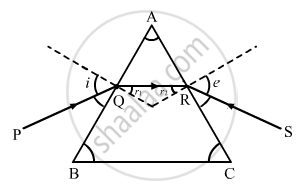Advertisements
Advertisements
प्रश्न
An equilateral glass prism has a refractive index 1.6 in the air. Calculate the angle of minimum deviation of the prism, when kept in a medium of refractive index `4sqrt(2)"/"5.`
उत्तर
When the prism is kept in another medium we have to take the refractive index of the prism with respect to the provided medium.
`"medium"^μ = ("μ"_"prism")/("μ"_"medium") = sin[((A + D_m)/2)]/sin(A/2)`
`1.6/((4sqrt(2))/5) = sin[((60^circ + D_m)/2)]/sin(60^circ/2)`
`sqrt(2) = sin[((60^circ + D_m)/2)]/(1/2)`
`sin^-1(1/sqrt(2)) = ((60^circ + D_m)/2)`
`90^circ = 60^circ + D_m`
`D_m = 30^circ`
APPEARS IN
संबंधित प्रश्न
What is the cause of dispersion of light
Describe an activity to show that the colours of white light splitted by a glass prism can be recombined to get white light by another identical glass prism. Also, draw a ray diagram to show the recombination of the spectrum of white light.
Figure shows a ray of light passing through a prism. If the refracted ray QR is parallel to the base BC, show that (i) r1 = r2 = A/2 and (ii) angle of minimum deviation, Dm = 2i − A.

The equation \[\omega = \frac{\mu_u - \mu_r}{\mu - 1}\] was derived for a prism having small refracting angle. Is it also valid for a prism of large refracting angle? Is it also valid for a glass slab or a glass sphere?
Can the dispersive power \[\omega = \frac{\mu_u - \mu_r}{\mu - 1}\] be negative? What is the sign of ω if a hollow prism is immersed into water?
If a glass prism is dipped in water, its dispersive power ___________ .
By properly combining two prisms made of different materials, it is possible to
(a) have dispersion without average deviation
(b) have deviation without dispersion
(c) have both dispersion and average deviation
(d) have neither dispersion nor average deviation
A thin prism of angle 6.0°, ω = 0.07 and μy = 1.50 is combined with another thin prism having ω = 0.08 and μy = 1.60. The combination produces no deviation in the mean ray. (a) Find the angle of the second prism. (b) Find the net angular dispersion produced by the combination when a beam of white light passes through it. (c) If the prisms are similarly directed, what will be the deviation in the mean ray? (d) Find the angular dispersion in the situation described in (c).
The deviation produced for violet, yellow and red lights for crown glass are 3.75°, 3.25° and 2.86° respectively. Calculate the dispersive power of the crown glass.
Calculate dispersive power of a transparent material given : nv = 1.56, nr = 1.54, ny = 1.55.
